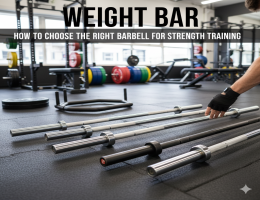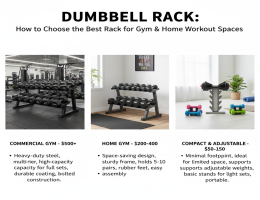
From Back Pain to Better Posture: How Fitness Can Save Your Spine
Posted on: 25 Sep, 2025
Back pain has become one of the most common health concerns of the 21st century. Whether you are a student spending hours in front of books or a professional glued to a laptop all day, chances are you have experienced stiffness, soreness, or nagging pain in your back. While occasional discomfort may seem harmless, ignoring it can eventually lead to poor posture, chronic pain, and even spinal problems.
The good news? Fitness can play a massive role in keeping your spine strong, improving posture, and reducing back pain. With the right mix of exercises, stretches, and equipment, you can take control of your spinal health before it becomes a bigger issue.
Common Causes of Back Pain
Before we jump into solutions, let’s understand why back pain has become so widespread:
- Poor Posture: Slouching while sitting or standing puts extra pressure on your spine.
- Sedentary Lifestyle: Sitting for long hours weakens muscles that support the spine.
- Weak Core Muscles: A weak core means your spine has less support, leading to strain.
- Improper Exercise Techniques: Lifting weights incorrectly or skipping warm-ups can trigger pain.
- Stress & Tension: Mental stress often shows up as muscle tightness in the back and shoulders.
If you’re just starting your fitness journey, check out our guide on home workouts for beginners.
Why Posture Matters for Your Spine
Your posture is more than just standing straight—it directly impacts the health of your spine. Good posture:
- Keeps your bones and joints in proper alignment.
- Reduces wear and tear on spinal discs and ligaments.
- Prevents muscle fatigue and strain.
- Improves breathing, digestion, and blood circulation.
On the other hand, poor posture can lead to rounded shoulders, a hunched back, and long-term spinal problems. A simple step like practicing stretches on a supportive yoga mat
can be the first move toward correcting posture.
How Fitness Helps Reduce Back Pain
The link between fitness and spinal health is undeniable. Here’s how different types of exercise can protect your spine:
1. Strength Training
Building muscle strength, especially in your core and back, provides better support to your spine. Exercises like squats, planks, and resistance band rows help balance posture and relieve stress on the lower back.
Try our durable resistance bands
for targeted back and shoulder strengthening.
2. Stretching & Yoga
Flexibility exercises reduce stiffness and increase spinal mobility. Poses like Cat-Cow, Cobra Stretch, and Child’s Pose are excellent for easing back tension.
Learn more in our guide on yoga for back pain relief.
3. Cardio Workouts
Low-impact activities such as walking, cycling, or swimming improve blood circulation, helping your spine recover from strain and inflammation.
4. Foam Rolling & Recovery
Using foam rollers for self-massage releases muscle knots and improves flexibility in the back muscles.
Best Exercises to Improve Posture
Here are some simple yet effective exercises you can do at home:
- Planks: Strengthen the core and stabilize the spine.
- Cat-Cow Stretch: Improves flexibility and relieves stiffness.
- Wall Angels: Opens up the chest and realigns the spine.
- Glute Bridges: Strengthens lower back and hip muscles.
- Resistance Band Rows: Corrects rounded shoulders and improves back strength.
Perform these exercises 3–4 times a week for long-lasting results.
Fitness Equipment That Supports Spine Health
While you can do bodyweight exercises, having the right equipment makes workouts more effective:
- Yoga Mats – Provide comfort and grip during stretching.
- Resistance Bands – Strengthen back and shoulder muscles.
- Foam Rollers – Aid recovery and improve flexibility.
- Stability Balls – Build balance and engage the core.
Explore our collection of fitness equipment designed for posture correction and back health.
Lifestyle Tips for a Healthy Spine
Fitness is important, but small lifestyle changes also make a huge difference:
- Sit with your back straight and feet flat on the ground.
- Take a 5-minute break every 30 minutes of sitting.
- Sleep on a mattress that supports spinal alignment.
- Stay active daily—avoid sitting for long hours without movement.
- Carry bags evenly on both shoulders to avoid imbalance.
Conclusion
Back pain doesn’t have to be a part of your everyday life. By combining regular fitness, posture awareness, and the right equipment, you can strengthen your spine and improve your posture naturally. Even small steps like practicing yoga, using resistance bands, and stretching daily can protect you from long-term spinal issues.
Start small, stay consistent, and let fitness be your best medicine for a healthy spine.
Explore our range of Koxtonsmart Fitness Equipment to begin your journey toward better posture and pain-free living today.
FAQs: Back Pain & Posture
Q1: Can exercise really reduce back pain?
A: Yes, exercise strengthens the muscles supporting your spine, reduces stiffness, and corrects posture, which lowers back pain risks.
Q2: Which exercises are best for posture correction?
A: Planks, Cat-Cow stretches, resistance band rows, and wall angels are highly effective.
Q3: How often should I exercise for spine health?
A: At least 20–30 minutes daily focusing on strength, flexibility, and posture.
Q4: Do I need special equipment for back pain workouts?
A: Not always, but using yoga mats, resistance bands, and foam rollers enhances effectiveness and safety.
Q5: Can poor posture lead to permanent damage?
A: Yes, if ignored, bad posture can cause spinal misalignment, slipped discs, and chronic pain over time.







Comments
No comment yet.